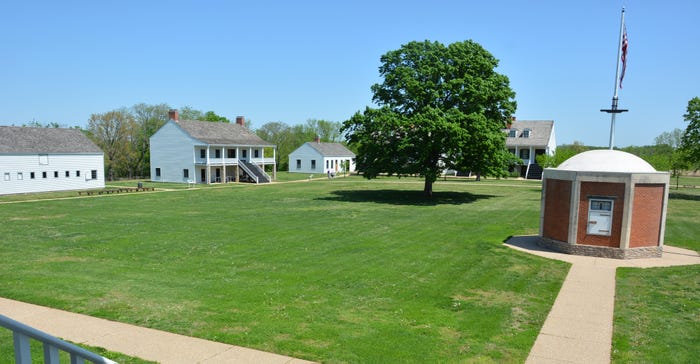
THE FORT: The Fort Scott National Historic Site offers a manicured parade ground surrounded by either original fort buildings or reconstructions. Some of the buildings were sold to the public at an auction held when the fort was closed in 1858. It was reopened when the Civil War began.
When it comes to history, Kansas has a lot to see and to learn, especially when it comes to the role that ‘Bleeding Kansas’ played in the Civil War.
I’ve visited and studied most of the places where history happened, partly as the result of research to co-author a Kansas history textbook for middle schoolers several years ago.
I’ve also been heavily influenced by Marci Penner, founder of the Kansas Sampler Foundation, the Kansas Sampler Festival, the Kansas Explorers, We Kan and other efforts to promote all things Kansas.
So, it came as a bit of shock to discover the first weekend of May that there was a major historical site that I had missed: The Fort Scott National Historic Site and the Fort Scott historic district.
I made a trip down to Fort Scott to check out the milking robots that are the latest innovation at Foster Dairy. You can read all about that in the June magazine when we celebrate Dairy Month with a look at robotic milking, which is offering hope to help smaller family dairies stay in business.
In the course of seeing what else I might learn while in the region, and in seeing if there was something that might help engage a grandkid or two (as though robots that milk cows didn’t get their attention!), that’s when I discovered the historic fort.
As a frontier state at the edge of Indian Territory, Kansas had a number of outposts to house the soldiers whose job it was to patrol the boundary between white settlement and American Indian lands, and to provide security for wagon trains moving west on the Santa Fe and Oregon trails.
That was Fort Scott’s initial mission. However, its proximity to the Missouri border also gave it an outsized role in the bloody years leading up to the Civil War.
Fort Scott’s Chamber of Commerce also offers a trolley ride that lasts about an hour and travels the streets of the historic section of town — now most occupied by ordinary families and businesses.
I was struck by how many historic structures have been maintained in the town, even though the trolley driver said there were dozens of historic buildings destroyed in the mid-20th century’s misguided notion of “urban renewal.” The ride also included a trip through the Fort Scott National Cemetery.
As a National Park Service site, the Fort Scott National Historic Site has beautifully curated exhibits and structures reconstructed, restored and maintained with historical accuracy and loving care. If you haven’t visited, I would urge you to go.
There’s even a bonus if you take school-age kids. The park rangers have books of “clues” to historic facts and exhibits that children can complete as they go through. Once their book is complete, they can be sworn in as “junior rangers” and get a badge. In the case of my two, grandma also sprang for the junior ranger hat to pin the badge to.
There’s nothing better than another great day of making memories and learning about agriculture and history with grandkids.
About the Author(s)
You May Also Like




